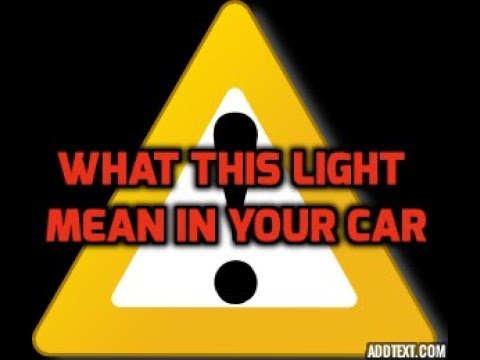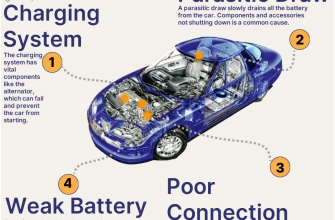Driving a vehicle is not just about steering the wheel; it’s about understanding the myriad signals your car is communicating with you. Among these signals, the yellow triangle warning light holds significant importance. This article delves into what this light indicates, the potential issues it may signify, and how to respond effectively when it illuminates.
- What Does the Yellow Triangle Warning Light Mean?
- Common Reasons for the Yellow Triangle Warning Light
- What Should You Do When the Light Comes On?
- Stay Calm and Assess the Situation
- Check Your Vehicle’s Manual
- Conduct a Quick Visual Inspection
- Utilize Technology
- Consider the Conditions
- Seek Professional Assistance
- Preventive Measures for the Future
What Does the Yellow Triangle Warning Light Mean?
The yellow triangle warning light, often accompanied by an exclamation mark, is a general warning indicator. Unlike specific lights that denote particular issues, such as the check engine light, this warning serves as a catch-all for various potential problems. Its purpose is to alert drivers that something requires attention, even if it’s not immediately clear what that something is.
Common Reasons for the Yellow Triangle Warning Light
When the yellow triangle light appears, it could be due to several reasons. Here are the most common:
- Low Tire Pressure: One of the most frequent triggers is low tire pressure. Many modern vehicles are equipped with Tire Pressure Monitoring Systems (TPMS) that will illuminate this light when tire pressure drops below the recommended level.
- Brake System Issues: A problem with the brake system, such as low brake fluid levels or worn brake pads, can also trigger the warning light. It’s crucial to address any brake-related issues promptly to ensure your safety.
- Engine Temperature Warning: Overheating can cause the yellow triangle light to glow alongside the engine temperature gauge. If this occurs, it’s essential to pull over safely and let your engine cool down.
- Stability Control System Malfunction: If your vehicle’s stability or traction control system detects a fault, it may trigger this warning light. This system is vital for maintaining vehicle control, especially in adverse driving conditions.
- Service Reminder: In some vehicles, the yellow triangle may simply indicate that routine maintenance is due. Check your owner’s manual for specifics on service intervals.
What Should You Do When the Light Comes On?
Spotting the yellow triangle warning light can be unsettling, but remaining calm is key. Here’s what you should do:
- Check for Other Warning Lights: Look at your dashboard for any other warning lights that may provide additional context. For instance, if the check engine light is also on, it could indicate a more severe issue.
- Pull Over Safely: If you can do so safely, pull over to the side of the road. This is particularly important if the light is accompanied by unusual noises or changes in vehicle performance.
- Consult Your Owner’s Manual: Your vehicle’s owner’s manual will provide specific information about the warning light and may offer troubleshooting tips tailored to your make and model.
- Perform a Visual Inspection: If you’re knowledgeable about vehicles, check the tire pressure, brake fluid levels, and coolant levels. Look for any visible signs of trouble.
- Seek Professional Help: If you’re unsure about the cause of the warning light or if it persists after addressing potential issues, visit a qualified mechanic. It’s always better to err on the side of caution.
The yellow triangle warning light serves as a crucial alert from your vehicle, signaling that something needs your attention. Understanding its meaning and responding appropriately can prevent minor issues from escalating into significant problems. Remember, regular maintenance and being attentive to your dashboard signals are vital components of safe driving. So, the next time you see that yellow triangle light, don’t ignore it—take action!
When that yellow triangle warning light flickers to life on your dashboard, it can feel like a small alarm bell ringing, urging you to take notice. While your initial instinct might be to panic, understanding how to respond can make all the difference. Here’s a deeper dive into the steps you should take when faced with this warning.
Stay Calm and Assess the Situation
First things first—take a deep breath. The yellow triangle light is a prompt for investigation, not an immediate cause for alarm. The first action should be to assess your surroundings and ensure it’s safe to pull over. Once you find a safe spot, turn off the engine and allow yourself a moment to gather your thoughts.
Check Your Vehicle’s Manual
Your vehicle’s manual is your best friend in times like this. It contains specific information about the dashboard lights and their meanings tailored to your make and model. Look for the section that discusses warning lights. This information can provide clarity on whether the issue is minor or something that requires immediate attention.
Conduct a Quick Visual Inspection
While you’re parked and assessing your vehicle, take the opportunity to perform a visual inspection. Start with the tires—check for any visible damage or low pressure. Next, pop the hood and check the fluid levels, including engine oil, coolant, and brake fluid. If you notice anything amiss, it may give you a clearer idea of the issue at hand.
Utilize Technology
If your vehicle is equipped with a diagnostic app or system, now is the time to use it. Many modern cars allow drivers to connect their smartphones to the vehicle’s onboard computer, providing real-time diagnostics and alerts. This can help pinpoint the issue more precisely than a simple dashboard light.
Consider the Conditions
Reflect on your recent driving conditions. Have you driven on rough terrain, experienced extreme weather, or noticed any changes in your car’s performance? These factors could contribute to the warning light’s appearance. Understanding the context can help identify the problem more effectively.
Seek Professional Assistance
If you’ve conducted your assessments but the yellow triangle light remains illuminated, it’s best to consult a professional mechanic. Ignoring the warning could lead to more significant issues down the road. A qualified technician can run comprehensive diagnostics to uncover any underlying problems that may not be immediately visible.
Preventive Measures for the Future
Once you’ve addressed the issue, consider implementing preventive measures to minimize the chances of encountering the yellow triangle warning light again. Regular maintenance, including tire rotations, fluid checks, and brake inspections, can help keep your vehicle in optimal condition. Additionally, staying attuned to your vehicle’s performance during daily drives can help you catch any anomalies before they escalate.
The yellow triangle warning light serves as a crucial signal that should not be ignored. By knowing how to respond effectively, you can ensure your safety and the longevity of your vehicle. Remember, the key is to stay calm, be proactive, and prioritize maintenance. After all, a well-cared-for vehicle is a reliable partner on the road.










This article is a must-read for all drivers! The explanation of low tire pressure and brake issues was particularly enlightening.
Great insights on vehicle warning lights! I never took the yellow triangle seriously until reading this. Very useful information!
I learned so much from this piece! The section on engine temperature warnings was especially crucial for me. Thanks for sharing!
I appreciate how this article explains the various reasons for the yellow triangle light. It’s a great reminder to stay vigilant about vehicle maintenance!
Fantastic read! The detailed descriptions of potential issues are very helpful. I feel more prepared to handle any warning lights now.
This article was incredibly informative! I had no idea what the yellow triangle warning light meant until now. Thank you for breaking it down so clearly!
Excellent information on the yellow triangle warning light! It’s comforting to know what to look out for in my vehicle.
Very well written and easy to understand. I feel more confident about my car